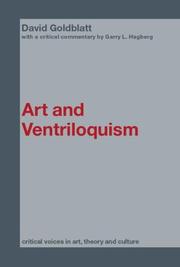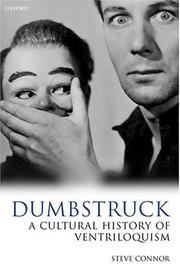| Listing 1 - 10 of 13 | << page >> |
Sort by
|
Book
Year: 1772 Publisher: A Londres : Et se trouve a Paris : Chez De l'Etanville ; Chez la Veuve Duchesne,
Abstract | Keywords | Export | Availability | Bookmark
 Loading...
Loading...Choose an application
- Reference Manager
- EndNote
- RefWorks (Direct export to RefWorks)
Book
ISBN: 9781032304762 1032304766 9781032290454 1032290455 Year: 2023 Publisher: New York : Routledge,
Abstract | Keywords | Export | Availability | Bookmark
 Loading...
Loading...Choose an application
- Reference Manager
- EndNote
- RefWorks (Direct export to RefWorks)
Ventriloquism, Performance, and Contemporary Art volume calls attention to the unexpected prevalence of ventriloqual motifs and strategies within contemporary art. Engaging with issues of voice, embodiment, power, and projection, the case studies assembled in this volume span a range of media from painting, sculpture, and photography to installation, performance, architecture, and video. Importantly, they both examine and enact ventriloqual practices, and do so as a means of interrogating and performatively bearing out contemporary conceptions of authorship, subjectivity, and performance. Put otherwise, the chapters in this book oscillate seamlessly between art history, theory, and criticism through both analytical and performative means. Across twelve essays on ventriloquism in contemporary art, the authors, who are curators, historians, and artists, shine light on this outdated practice, repositioning it as a conspicuous and meaningful trend within a range of artistic practices today. This book will be of interest to scholars working in art history, contemporary art, media studies, performance, museum/curatorial studies, and theater.

ISBN: 1315019000 1136578331 9781136578403 1136578404 9781315019000 0415370590 9780415370592 0415370604 9780415370608 9781136578335 9781136578472 1136578471 Year: 2006 Publisher: London ; New York : Routledge,
Abstract | Keywords | Export | Availability | Bookmark
 Loading...
Loading...Choose an application
- Reference Manager
- EndNote
- RefWorks (Direct export to RefWorks)
This exciting collection of David Goldblatt's essays, available for the first time in one volume, uses the metaphor of ventriloquism to help understand a variety of art world phenomena. It examines how the vocal vacillation between ventriloquist and dummy works within the roles of artist, artwork and audience as a conveyance to the audience of the performer's intentions, emotions and beliefs through a created performative persona. Considering key works, including those of Nietzsche, Foucault, Socrates, Derrida, Cavell and Wittgenstein, Goldblatt examines how the authors use the framework of
Ventriloquism --- Amusements --- Elocution --- Voice --- Philosophy. --- Philosophy --- Ventriloquism - Philosophy

ISBN: 0198184336 0191674206 0191541842 1280444924 9786610444922 9781280444920 9780198184331 9780191674204 Year: 2000 Publisher: Oxford: Oxford university press,
Abstract | Keywords | Export | Availability | Bookmark
 Loading...
Loading...Choose an application
- Reference Manager
- EndNote
- RefWorks (Direct export to RefWorks)
This book provides a history of ventriloquism and the disembodied voice. It tracks the subject from its beginnings through early Christian writers, the voice in mysticism witchcraft and the figure of the ventriloquist.
Ventriloquism --- History --- Social aspects --- -Ventriloquism --- -Amusements --- Elocution --- Voice --- -History --- Amusements --- Buikspreken. --- Culturele aspecten. --- Ventriloquism. --- History. --- Social aspects. --- Ventriloquism - History --- Ventriloquism - Social aspects --- Ventriloquie --- Histoire --- Aspect social
Book
ISBN: 9789503412435 Year: 2015 Publisher: Universidad Nacional de La Plata. Facultad de Humanidades y Ciencias de la Educación
Abstract | Keywords | Export | Availability | Bookmark
 Loading...
Loading...Choose an application
- Reference Manager
- EndNote
- RefWorks (Direct export to RefWorks)
The book addresses the problem of the subject from the figure of ventriloquism. In a general sense, an attempt is made to think of the history of Western man from the tension of two discursive voices or poles (the muthos and the logos ) and the subject (the man) as the effect or result of that tension. The central hypothesis is that in the face of the hegemonic tradition of “logocentrism”, which tries to reduce the plurality of meaning to a single voice (the logos ) and to constitute history as a history of that only meaning, it is possible to detect a second voice ( the muthos ), heterogeneous and so to speak peripheral, which subverts, at each historical moment, the strategies of the logosdominant. This second voice also finds its paradigmatic place in the figure of the ventriloquist. The text proposes, from this perspective, to make a reconstruction of this curious figure, to show that the human, that is, the different images or conceptions that man has formed of himself throughout history are, in truth, the product or the effect of the tension between these two voices or phonetic principles. This tension between the muthos and the logos , in each historical epoch, is embodied in certain paradigmatic figures: the fortune teller and the prophet; the witch and the inquisitor; the possessed and the exorcist; the magnetic sleepwalker and the doctor; the schizophrenic and the psychiatrist, etc. As well as the voice of the logosit finds its place of origin in the mouth, likewise the muthos finds its place, according to the etymology of the term "ventriloquism", in the womb. The human, consequently, is nothing but the rest or, better still, the residue or the sequel of the joints and disarticulations that historically occur between the mouth and the belly, between the logos and the muthos .
Ventriloquism. --- Amusements --- Elocution --- Voice --- Ventriloquia --- Sujeto
Book
Year: 2016 Publisher: Project Gutenberg
Abstract | Keywords | Export | Availability | Bookmark
 Loading...
Loading...Choose an application
- Reference Manager
- EndNote
- RefWorks (Direct export to RefWorks)
Magic tricks --- Handbooks --- manuals --- etc. --- Ventriloquism
Book
Year: 2016 Publisher: Project Gutenberg
Abstract | Keywords | Export | Availability | Bookmark
 Loading...
Loading...Choose an application
- Reference Manager
- EndNote
- RefWorks (Direct export to RefWorks)
Magic tricks --- Handbooks --- manuals --- etc. --- Ventriloquism
Book
ISBN: 1283924331 1574414550 9781574414554 9781283924337 9781574414479 157441447X Year: 2012 Publisher: Denton, Tex. : University of North Texas Press,
Abstract | Keywords | Export | Availability | Bookmark
 Loading...
Loading...Choose an application
- Reference Manager
- EndNote
- RefWorks (Direct export to RefWorks)
Ventriloquism --- Ventriloquists --- Fatherhood --- Amusements --- Elocution --- Voice --- Actors --- Entertainers --- Parenthood
Book
Abstract | Keywords | Export | Availability | Bookmark
 Loading...
Loading...Choose an application
- Reference Manager
- EndNote
- RefWorks (Direct export to RefWorks)
La figure du ventriloque accompagné de sa marionnette sur les genoux est contemporaine de l'invention du cinéma. Simple coïncidence ? Son art, remarquons-le, s'inscrit dans l'histoire des médias techniques qui ont dissocié le corps de la voix, qu'il s'agisse du phonographe ou du téléphone, actualisant les puissances de la voix acousmatique. Curieusement le ventriloque apparaît à l'écran dès l'âge du muet en jouant sur le registre de l'étonnement et de l'inquiétude par des effets de dissociation et de dédoublement. Nombreux sont les films qui explorent sa personnalité insolite, ambivalente, en proie au larcin, à la simulation, au désordre psychique. Au-delà de la présence littérale du ventriloque, on peut observer un usage plus métaphorique de la ventriloquie dans les effets fantastiques de la voix dissociée, le rôle du bonimenteur ou du traducteur, le contrepoint du visuel et du sonore. Autant de stratégies qui permettent, en dénudant le procédé cinématographique, en renversant le principe d'autorité, de donner à entendre des voix dissidentes. Sans doute la ventriloquie trouble-t-elle l'opposition par trop schématique de la lettre et de la métaphore au gré de ses jeux de symétrie et de réversibilité. Qui est le ventriloque de qui ? Le critique est-il le ventriloque du film, ou l'inverse.
Ventriloquism --- Motion pictures --- Ventriloquie --- Cinéma --- Plots, themes, etc. --- Au cinéma. --- Thèmes, motifs --- Ventriloques --- Au cinéma
Book
ISBN: 9783039107476 303910747X Year: 2009 Publisher: Frankfurt am Main [etc.] Peter Lang
Abstract | Keywords | Export | Availability | Bookmark
 Loading...
Loading...Choose an application
- Reference Manager
- EndNote
- RefWorks (Direct export to RefWorks)
How do objects 'speak' to us? What happens to authorship when voice is projected into inanimate objects? How can one articulate an object into speech? Is the inarticulate body necessarily silent? These are just some of the questions brought up by this unique and unusual collection of essays, which presents subjects and categories often overlooked by the disciplines of art history, visual culture, theatre history and comparative literature. Drawing from and expanding upon the 'Performing Objects, Animating Images' academic session run by the Henry Moore Institute at the Association of Art Historians conference, held in London in 2003, this book presents thirteen essays that bring together a multidisciplinary approach to the animated object. Contributions range from literal accounts of magic lanterns, tableaux vivants, puppets and ventriloquist dummies, to the more abstract notions of voice displacement in audio art and authorship projection in writing machines. The contributors come from diverse backgrounds in art history, cultural history, comparative literature, and artistic, theatrical and curatorial practice, and all tackle the issue of 'articulate objects' from a range of lively and unexpected perspectives.
Arts, Modern --- Arts, Modern. --- Klang. --- Kunst. --- Mechanisches Kunstwerk. --- Object (Aesthetics) --- Object (Aesthetics). --- Objet (Esthétique) --- Performance --- Puppet theater. --- Sound in art --- Sound in art. --- Stimme. --- Technologie et arts --- Technology and the arts --- Technology and the arts. --- Ventriloquie --- Ventriloquism --- Ventriloquism. --- Voice in art --- Voice in art. --- Voix dans l'art
| Listing 1 - 10 of 13 | << page >> |
Sort by
|

 Search
Search Feedback
Feedback About UniCat
About UniCat  Help
Help News
News